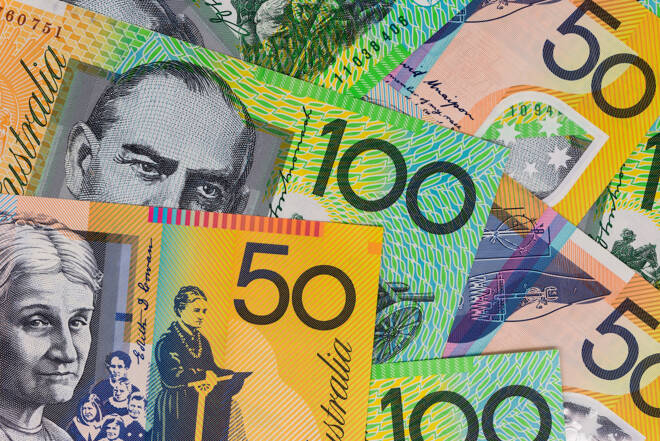Advertisement
Advertisement
AUD to USD Forecast: Australian Trade Surplus Drops Below A$11 Billion
By:
Australian trade and services sector data drew interest on Monday. However, service sector data from China and the US also need consideration.
Highlights
- The AUD/USD slid by 0.89% on Friday, ending the session at $0.65135.
- On Friday, the US Jobs Report sent the Aussie dollar deep into negative territory.
- In December, the Australian trade surplus narrowed on a smaller increase in exports.
Friday Overview of the AUD/USD
The AUD/USD slid by 0.89% on Friday. Reversing a 0.07% gain from Thursday, the Australian dollar ended the session at $0.65135. The Australian dollar rose to a high of $0.66104 before falling to a low of $0.65024.
Australian Services PMI and Trade Data in Focus
On Monday, Australian Services PMI numbers for January and trade data for December drew investor interest.
In January, the Judo Bank Services PMI increased from 47.1 to 49.1, surpassing the preliminary reading of 47.9. Accounting for over 60% of the Australian economy, the continued contraction supported bets on the RBA ending its rate hike cycle.
However, trade data for December had more impact.
The Australian trade surplus narrowed from A$11.437 billion to A$10.959 billion. Economists forecast the trade surplus to narrow to A$11.000 billion.
According to the ABS,
- Exports increased by 1.8% (A$847 million) in December.
- Non-monetary gold exports surged by 20.2% (A$491 million).
- Non-rural goods exports increased by 0.9% (A$327 million).
- Imports jumped by 4.8% (A$1,652 million) in December.
- Consumption goods imports increased by 9.8% (A$995 million).
- Intermediate and other merchandise goods imports rose by 4.5% ($683 million).
Later in the session, investors must also consider service sector data from China. Economists expect the Caixin Services PMI to remain unchanged at 52.9 in January.
An unexpected pickup in service sector activity could drive buyer demand for the Aussie dollar. An improving macroeconomic environment could signal a pickup in demand.
China accounts for one-third of Australian exports. Australia has a trade-to-GDP ratio of over 50%, with 20% of the Australian workforce in trade-related jobs. A pickup in demand would be a boon for the Australian economy and the Aussie dollar.
US Economic Calendar: ISM Manufacturing PMI and the Fed in Focus
On Monday, ISM Non-Manufacturing PMI numbers for January warrant investor attention. Economists forecast the ISM Non-Manufacturing PMI to increase from 50.6 to 52.0. However, investors must also consider the sub-components, including prices and employment.
The services sector accounts for over 70% of the US economy. After the US Jobs Report, an upward trend in prices driven by wage growth would impact hopes of a March Fed rate cut. Higher wages could increase disposable income. Higher disposable income could fuel consumer spending and drive demand-driven inflation.
A higher-for-longer Fed rate path could reduce disposable income and curb consumer spending.
Beyond the numbers, investors must monitor Fed speakers. FOMC member Raphael Bostic is on the calendar to speak on Monday. Reactions to the US Jobs Report and comments relating to inflation and interest rates would move the dial.
Short-Term Forecast
Short-term trends in AUD/USD are contingent on US service sector performance, Australian trade data, and the RBA. Weaker Australian trade terms, increased US service sector activity, and a less hawkish RBA may favor the US dollar in monetary policy divergence.
AUD/USD Price Action
Daily Chart
The AUD/USD remained below the 50-day and 200-day EMAs, affirming bearish price signals.
An AUD/USD return to the $0.65500 handle would support a move to the 200-day EMA. A break above the 200-day EMA would bring the 50-day EMA and the $0.66162 resistance level into play. Selling pressure could intensify at the $0.66162 resistance level. The 50-day EMA is confluent with the $0.66162 resistance level.
Stimulus chatter from China, economic indicators from China, US data, and Fed commentary need consideration.
However, a fall below the $0.64900 support level would bring the $0.63854 support level into view.
A 14-period Daily RSI reading of 31.80 suggests an AUD/USD drop below the $0.64900 support level before entering oversold territory.
4-Hourly Chart
The AUD/USD sat below the 50-day and 200-day EMAs, reaffirming the bearish price signals.
An AUD/USD move to the $0.65500 handle would bring the 50-day EMA into play. A break above the 50-day EMA would support a move toward the $0.66162 resistance level and 200-day EMA.
However, a break below the $0.64900 support level would support a fall toward the $0.63854 support level.
The 14-period 4-Hourly RSI at 34.14 suggests an AUD/USD break below the $0.64900 support level before entering oversold territory.
About the Author
Bob Masonauthor
With over 28 years of experience in the financial industry, Bob has worked with various global rating agencies and multinational banks. Currently he is covering currencies, commodities, alternative asset classes and global equities, focusing mostly on European and Asian markets.
Did you find this article useful?
Latest news and analysis
Advertisement
